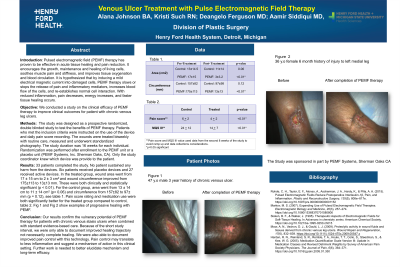Case Series/Study
(CS-129) Venous Ulcer Treatment with Pulse Electromagnetic Field Therapy.

Pulsed electromagnetic field (PEMF) therapy has proven to be effective in acute tissue healing and pain reduction. It encourages the growth, maintenance and healing of living cells, soothes muscle pain and stiffness, and improves tissue oxygenation and blood circulation. It is hypothesized that by inducing a mild electrical magnetic current into damaged cells, PEMF therapy slows or stops the release of pain and inflammatory mediators, increases blood flow of the cells, and re-establishes normal cell interaction. With reduced inflammation, pain decreases, energy increases, and faster tissue healing occurs.
Methods:
The study was designed as a prospective randomized, double blinded study to test the benefits of PEMF therapy. Patients who met the inclusion criteria were instructed on the use of the device and daily pain score recording. The wounds were treated biweekly with routine care, measured and underwent standardized photography. The study duration was 16 weeks for each individual. Randomization was performed after enrollment to the PEMF unit or a placebo unit (Pemf Systems, Inc. Sherman Oaks, CA). Only the study coordinator knew which device was provide to the patient.
Results:
33 patients completed the study. No patient sustained any harm from the devices. Six patients received placebo devices and 27 received active devices. In the treated group, wound area went from 17 ± 15 cm to 2 ± 3 cm2 and wound circumference improved from 175±113 to 13±13 mm. These were both clinically and statistically significant (p < 0.01). For the control group, area went from 13 ± 14 cm to 11 ± 14 cm2 (p= 0.06) and circumference from 157±82 to 97± mm (p = 0.12), see table 1. Pain score rating and medication use were both significantly better for the treated group compared to control, table 2. Fig 1 and Fig 2 show examples of progressive healing with PEMF.
Discussion:
Our results confirm the vulnerary potential of PEMF therapy for patients with chronic venous stasis ulcers when combined with standard evidence-based care. Because of the short study interval, we were only able to document improved healing trajectory not necessarily complete healing. We were also able to document improved pain control with this technology. Pain control may translate to less inflammation and suggest a mechanism of action in this clinical setting. Further work is needed to better elucidate mechanism and long-term efficacy.
Trademarked Items: wound healing stimulation device provided by PEMF systems.
wound imaging and documentation by sihoutte cameras aranz medical, christchurch, new zealand
References: Rohde, C. H., Taylor, E. F., Alonso, A., Ascherman, J. A., Hardy, K., & Pilla, A. A. (2015). Pulsed Electromagnetic Fields Reduce Postoperative Interleukin-1β, Pain, and Inflammation. Plastic and Reconstructive Surgery, 135(5), 808e–817e. https://doi.org/10.1097/prs.0000000000001152
Markov, M. S. (2007). Expanding Use of Pulsed Electromagnetic Field Therapies. Electromagnetic Biology and Medicine, 26(3), 257–274. https://doi.org/10.1080/15368370701580806
Sisken, B. F., & Walker, J. (1995). Therapeutic Aspects of Electromagnetic Fields for Soft-Tissue Healing. In Advances in chemistry series. American Chemical Society. https://doi.org/10.1021/ba-1995-0250.ch015
Moor, A. N., Vachon, D. J., & Gould, L. J. (2009). Proteolytic activity in wound fluids and tissues derived from chronic venous leg ulcers. Wound Repair and Regeneration, 17(6), 832–839. https://doi.org/10.1111/j.1524-475x.2009.00547.x

.png)